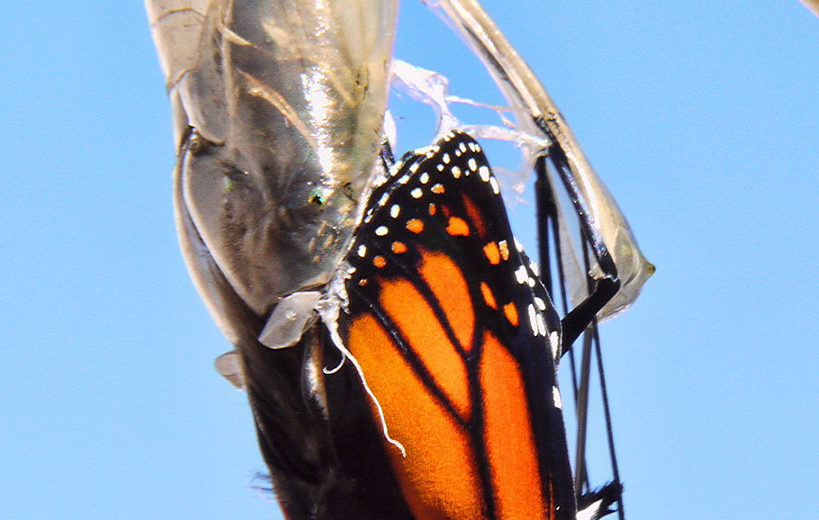Monarchs, Migrations, and Miracles

Written by Alicia Daniel.
For 25 years, Alicia has reared monarchs from chubby black and yellow caterpillars with soft green bellies, to chrysalises, to butterflies. She binge-watches the terrarium, hoping to catch a caterpillar shedding its skin, becoming, for a moment, wriggling goo. Later, she takes the darkening chrysalis with her, tied to a goldenrod stem, so that she can see the butterfly somersault out of the clear confining membrane, unfolding its tiny origami wings and pumping fluid out from its fat abdomen. After the wings dry, she watches the monarch waft away. Last fall, Alicia told this story at the Vermont Master Naturalist Art Hop Storytelling event called Wild Burlington!
I first crossed paths with monarchs in Colorado the summer I turned five. My older brother and I found a dead monarch in the backyard. Its black and orange wings had dried straight out from its body, as if frozen in flight. We decided to heal it, which involved gently anointing the furry black body with water. We were called in to lunch. When we came back outside, the butterfly was gone. I looked up just in time to see a monarch fly over the garden wall. I ran inside to tell my grandmother, who called the story “hogwash.” As a devout Christian, she of all people should have embraced this resurrection. I didn’t argue with her, but I knew a miracle when I saw one.
In Vermont, I have spent many happy hours hunting caterpillars in knee-deep milkweed in nearby meadows, which are sadly disappearing. The height and the buttery softness of the leaves tell me the milkweed is once mowed, creating the perfect hunting ground for monarch caterpillars. As I weave through a field, my corgi, Zeus, leading the way, my eyes scan the milkweed. I look for telltale signs: a pattern of bites taken out in small arcs about the size of a fingernail, and tight bundles of digested leaves the size and shape of miniature rabbit poop. But the meadows aren’t the only thing getting harder to find: so are the caterpillars.
I was born in Texas and journeyed north to Vermont in stages. Alone in the car, I still sometimes listen to country and western music. When it comes to monarchs, I really understand the line from country band Old Dominion’s song, “You gotta love like there is no such thing as a broken heart.”
There is heartbreak in my love affair with monarchs. One graph distributed by the Center for Biological Diversity shows that monarch populations have fallen more than 80% in the past two decades. The data is collected by measuring the total cover in their wintering grounds, where they congregate in the tops of oyamel firs in numbers that turn whole trees orange. The oyamel firs are themselves one of the rarest forest types in Mexico, growing only at higher, cooler elevations. A perfect storm of factors, including global warming, pesticides, logging in their Mexican wintering grounds, and houses sprawling into their meadows, here in Vermont, and everywhere else, are contributing to a war on milkweed and monarchs.
Some people are fighting back by planting milkweed, protecting wintering grounds, trying to limit or reverse global warming, and confronting the stubborn nature of human sprawl. For us to wake up in time to avert a monarch tragedy will take…well, a miracle.
When someone first gave me a chrysalis nestled on a pad of cotton and wrapped in a box decades ago, I thought the chrysalis was a piece of jewelry—a jade pendant glistening with gold flecks. But it was not an exquisite, man-made object. Inside the living chrysalis, the caterpillar, releasing enzymes to dissolve all of its tissues, had digested itself. In the protein-rich soup, rapid cell division was driving the formation of wings, antennae, legs, eyes, and all the other features of an adult butterfly. The adult would soon rise from cells poetically named imaginal discs.
Perhaps we will find the transformative powers within us to save not only monarchs, but also other life around us—to find ways to let other beings continue their own dance of development, regeneration, and rebirth. Even though I am not five anymore, I still believe in miracles. And I believe in giving miracles a hand.
